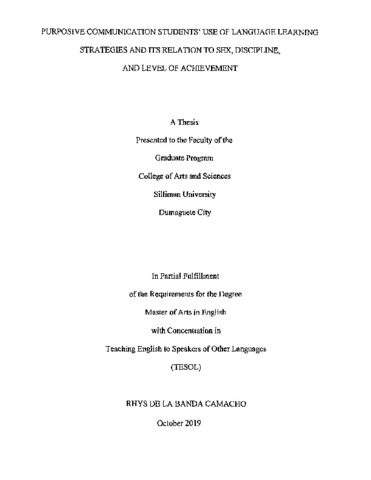Purposive communication students’ use of language learning strategies and its relation to sex, discipline, and level of achievement

Page views
3,767Petsa
2019May-akda
Tagapayo ng Tesis
Tagapangulo ng Panel ng Depensa
Magbahagi
Metadata
Ipakita ang buong tala ng item
Abstract
Due to the reform in the educational landscape of the Philippines, there have been major changes, particularly in the college curricula. With these changes, teachers and, particularly, students have been coping with the demands of the new General Education (GE) subjects, and one of these is Purposive Communication. It is therefore imperative to look into the learning process of the students, specifically on what strategies they use to satisfactorily comply with the requirements in the new GE subjects.
This research intended to assess the dominant language learning strategies (LLSs) used by Central Philippine University (CPU) Purposive Communication (GE 1) students. It also sought to find out whether there are significant differences in the following: LLSs used by male and female GE 1 students, LLSs used by GE students from different disciplines, and LLSs used by high-proficiency and average-proficiency students. The participants in the study were the randomly selected 309 male and female first-year general education students (out of 34 sections from 7 colleges) using the Slovin’s formula with 0.05 margin of error. Oxford’s (1990) Strategy Inventory for Language Learning (SILL) questionnaire, and the final grades of the students in their GE 1 class were used as measures of learning strategy preferences and academic achievement, respectively. To corroborate the answers from the questionnaire, twelve College of Business and Accountancy (CBA) students were selected (employing the purposive sampling) for the semi-structured interview.
Quantitative and qualitative data analyses generated meaningful findings related to the use of learning strategies. Based on the final individual grades and the corresponding answers of the students to Oxford’s (1990) SILL questionnaire, the most dominantly used LLSs among the advanced group are the metacognitive strategies. Affective strategies were the least dominantly employed out of the six LLSs. The same result was revealed in terms of level of achievement. The average-achieving GE 1 students used metacognitive strategies as their most dominant LLSs, and the affective strategy as the least dominant LLSs. Moreover, metacognitive strategies were the most dominantly employed LLSs among GE 1 students from the seven disciplines. No significant difference was identified between LLSs and sex, and LLSs and level of achievement. However, a significant difference existed between LLSs and discipline. A further recommendation is that future studies explore the role of learning strategies on both cognitive and affective outcomes in technology-based learning setting.
Paglalarawan
Abstract only
Mungkahing Sipi
Camacho, R. D. (2019). Purposive communication students’ use of language learning strategies and its relation to sex, discipline, and level of achievement (Unpublished Master’s thesis). Silliman University, Dumaguete City.
Uri
ThesisMga Paksa
Kagawaran
Graduate Program, College of Arts and SciencesDegree
Master of Arts in English with Concentration in Teaching English to Speakers of Other Languages (TESOL)Lokasyon ng Istante
GSL Theses 378.242 C140
Pisikal na paglalarawan
x, 179 leaves
Collections
- Theses [18]

